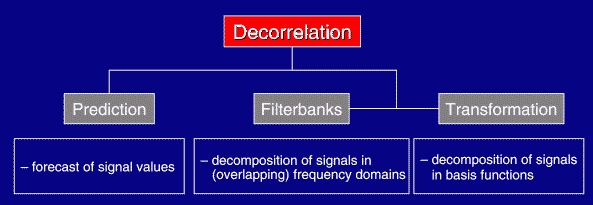Data Compression - Systematisation
---- Decorrelation ----
by T.Strutz
Figure 6: 
The goal of decorrelation techniques is to concentrate the signal information or signal energy to few signal samples. Typically, this is connected with a separation of relevant and irrelevant signal parts supporting a following data reduction. The success of this operations is based on the knowledge of the signal characteristics. In audio and image compression schemes we assume that the magnitudes of adjacent samples are similar. This kind of statistical bindings can be dissolved by prediction, signal transforms or filterbanks. Contrary to precoding methods, which also remove correlations between symbols, the number of signal values do not change. The result of prediction is called prediction-error signal, transformation coefficients are the result of transforms, and filterbank analysis yields so-called subbands.
In lossy-compression applications the decorrelation method has to be tolerant against signal alterations by quantisation of the decorrelated signal (e.g. prediction-error signal) in terms of moderate subjective reconstruction errors.
Strutz / 17.02.2003

